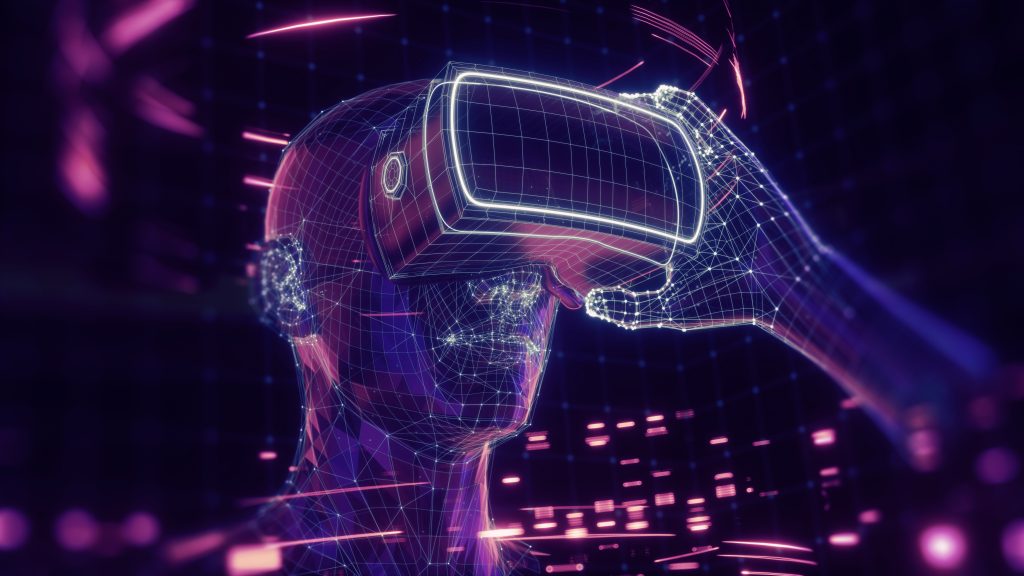“The Metaverse could have virtual creations by avatars and AI aspects built into them. If such innovations are deemed AI creations and not human creations, they may not be allowed certain types of intellectual property protection.”
 Companies spend billions and invest heavily in technologies that offer greater telepresence and enable an individual’s digital life. Will humans interact with each other via avatars in a three-dimensional virtual space? The “Metaverse” has ramifications for everything people do to live, work and play together digitally.
Companies spend billions and invest heavily in technologies that offer greater telepresence and enable an individual’s digital life. Will humans interact with each other via avatars in a three-dimensional virtual space? The “Metaverse” has ramifications for everything people do to live, work and play together digitally.
The Metaverse is a digital shared space where everyone can seamlessly interact in a fully immersive, simulated experience. The Metaverse increases the permeability of the borders between various digital environments and the physical world. In the Metaverse, you can interact with virtual objects and real-time information. A place where people join together to create, work, and spend time together in an environment that mixes what is virtual and what is real.
The Metaverse will allow digital assets, information, and content to move seamlessly across platforms. Users can share videos of their avatars driving with friends or even challenge them to races with money on the line. Users will purchase digital goods that enhance their experience in the Metaverse and physical goods to be delivered to them at their homes. There will be no limits on concurrent users in the Metaverse, and users will design their content and experiences, express their individuality through photorealistic avatars.
The different types of activities that will take place in the Metaverse are limitless. Companies are continuously trying to up the ante and keep us engaged and entertained. The Metaverse will offer fully immersive gaming experiences exceeding current Virtual Reality product offerings tenfold. It has the great potential to transform working, shopping, socializing, and gaming experiences…and even sports.
Investing in the Metaverse
The “Metaverse” is the newest chapter in entertainment, and its growing popularity means investors should pay careful attention.
Every day the sector is growing. It’s still unclear what the Metaverse will look like, but according to Strategy Analytics, the global Metaverse could be worth $280 billion by 2025 and likely grow from there. This market forecast amplifies the interest in Metaverse companies bringing new ways to interact with users, which intersects with a world spent indoors and a rise in technological capabilities available to innovators.
With all this excitement buzzing around the Metaverse, and the rapidly increasing interest from foremost industry leaders, investing in Metaverse will undoubtedly be on the rise. Becoming a pioneer in the new has paid off for many. Think about early investors in and adopters of Bitcoin. As it stands, the Metaverse is shaping up to be the next big wave for investors.
Activities that will take place in the Metaverse are multiplying by the day. The Metaverse will offer fully immersive gaming experiences exceeding current Virtual Reality product offerings by exponents. It already can transform the sports, working, shopping, socializing, and gaming experience.
Activities in the Metaverse
If you follow trends in the business of sports, how we watch games is on the roadmap. Rather than watching TV from your favorite chair, fans will have the experience of viewing a game as if they are in the stands. Everyone could one day have courtside seats in the house and their live bets shown on the jumbotron. At-home fans will influence the game just the way a hollering home crowd can.
The spectator experience could be disrupted altogether as an entire digital NBA could spring up.
Just as Disney has done with its streaming service, major sports leagues will be able to leverage their intellectual property when the time is right. For now, they are mainly lending IP to existing online realities like Fortnite.
The Metaverse could potentially offer fans physical seats or Go-like games unlocked in arenas and played on phones.
The Metaverse could also mean fandom doesn’t end at stadium gates. An interoperable Metaverse connection to the real world could allow leagues and retailers to sell physical sneakers and jerseys and their digital equivalents simultaneously.
And think about it in terms of athletic training. A young athlete could add some VR training regimen to further their training.
There is no limit to the types of activities that will take place in the Metaverse, nor are the lines between them exceedingly clear. That said, there are core capabilities that users can look forward to.
- Socializing– Customizable avatars and group experiences will usher in a new age of social interaction in the Metaverse. Already major events such as weddings, happy hours, and cooking classes are increasingly taking place digitally, with users in various geographic locations. This is expected to continue as new engagement apparatuses are introduced.
- Shopping – Virtual shopping malls will allow participants to purchase both digital and real-world clothing and more. With the development of Virtual try-on software and other tools that assist shoppers, this trend will soon become the norm.
- Working– The Metaverse has not fully leveraged the opportunity for remote work, and much remains to come. Virtual conferences and virtual meetings and a host of tools specifically designed to facilitate collaboration by distributed teams continue to develop.
- Gaming– The Metaverse will offer full immersion gaming experiences far exceeding current Virtual Reality product offerings. The gaming space seems especially likely to play a role in bringing the Metaverse to fruition.
The term “Metaverse” is the combination of “meta” and “universe.” This concept allows users to interact in virtual worlds, buying and selling names, goods, services, and avatars, organizing, hosting, and attending events.
It is using blockchain technologies and digital currencies that consumers can transact in the Metaverse. Blockchain is a distributed ledger technology that networks computers to share information chains across the internet in blocks. For example, Bitcoin uses blockchain technology to verify transactions on its ledgers. Some newer platforms are powered by blockchain technologies that use digital currencies and non-fungible tokens (“NFTs”), allowing a new decentralized digital asset to be owned, and monetized.
The NFT is a virtual asset that promotes the metaverse. It’s an intangible digital product that links ownership to unique physical or digital items. Each NFT is unique and irreplaceable. If you own an NFT, it will be recorded on the blockchain, and you can use it for electronic transactions. In fact, with NFTs, artifacts can be tokenized to create ownership digital certificates for electronic transactions.
The Legal Metaverse
Whether humans interact in a universe, multiverse, or Metaverse, as soon as human behavior occurs, one has to ask what laws apply and which body should set the policies and defines the rules. Wherever there are humans, there is imperfect behavior. Can the virtual world where interactions are taking place regulate fraud and prevent manipulative practices? In a decision rendered on Friday regarding VanEck’s spot bitcoin ETF proposal, the SEC rejected the idea, withholding approval of the application unless and until a surveillance mechanism can be put in place to allow the regulator to deter and sanction market manipulation. Given the number of transactions involving human interaction, freedom from fraudulent transactions can not be assumed, and our policymakers have insisted that surveillance be required.
The law is also a step behind technology, as technology by definition develops more rapidly, with legal norms following in reaction to the developments. Of course, the Metaverse will have legal implications. One issue will be collaboration and interoperability among different Metaverse creators. If the purpose of the Metaverse is to allow people to interact in a digital world, each Metaverse should be accessible from all devices and headsets. This may involve technology companies having to agree to specific standards for a Metaverse so that they can interoperate among different creators, or each company will have to comply with the technology constraints built by its predecessors and license the rights to use another company’s underlying technology to build its Metaverse.
Another issue will be intellectual property ownership. A recent artificial intelligence case in which the U.S. District Court for the Eastern District of Virginia held that an AI system cannot be named an inventor on a patent. Unlike U.S. patent law, U.S. copyright law does not have an express requirement of human authorship; however, U.S. courts and the U.S. Copyright Office generally operate based on this requirement and deny registrations of works not created by humans. In fact, the Compendium of U.S. Copyright Office Practices-a manual produced by the U.S. Copyright Office, intended for use primarily by the Copyright Office staff as a general guide to policies and procedures such as registration, deposit, and recordation-states, “the term ‘authorship’ implies that, for a work to be copyrightable, it must owe its origin to a human being.” Materials produced solely by nature, by plants, or by animals are not copyrightable. The Metaverse could have virtual creations by avatars and AI aspects built into them. If such innovations are deemed AI creations and not human creations, they may not be allowed certain types of intellectual property protection.
The Metaverse could also pose issues for content owners, as it will be difficult to police copyright infringement. Content licensees will need to carefully review their license agreements to ensure the right to use licensed content in the Metaverse. Many license agreements did not consider the use of licensed content in such forums.
The above are just a handful of legal issues that the creation of a Metaverse will pose. Other vital issues such as data protection and privacy will come to the forefront immediately as each develops and more people begin to interact.
It will take years for the total immersion of unique digital avatars bouncing between digital spaces to come together.
As different products, services, and capabilities integrate and meld together, and investors pour capital into the space, many new developments are expected within the legal Metaverse. Watch this space.
Image Source: Deposit Photos
Image ID:236672872
Copyright:wacomka

![[IPWatchdog Logo]](https://ipwatchdog.com/wp-content/themes/IPWatchdog%20-%202023/assets/images/temp/logo-small@2x.png)


![[Advertisement]](https://ipwatchdog.com/wp-content/uploads/2024/04/UnitedLex-May-2-2024-sidebar-700x500-1.jpg)
![[Advertisement]](https://ipwatchdog.com/wp-content/uploads/2024/04/Artificial-Intelligence-2024-REPLAY-sidebar-700x500-corrected.jpg)
![[Advertisement]](https://ipwatchdog.com/wp-content/uploads/2024/04/Patent-Litigation-Masters-2024-sidebar-700x500-1.jpg)

![[Advertisement]](https://ipwatchdog.com/wp-content/uploads/2021/12/WEBINAR-336-x-280-px.png)
![[Advertisement]](https://ipwatchdog.com/wp-content/uploads/2021/12/2021-Patent-Practice-on-Demand-recorded-Feb-2021-336-x-280.jpg)
![[Advertisement]](https://ipwatchdog.com/wp-content/uploads/2021/12/Ad-4-The-Invent-Patent-System™.png)






Join the Discussion
One comment so far.
Scott Hertzog
December 2, 2021 01:54 pmAm I the only one that keeps being reminded of the video game “Second Life” when seeing pieces about the Metaverse? ?